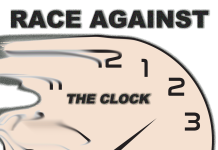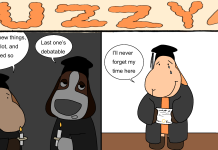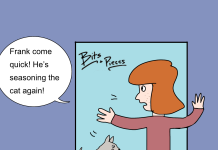You stand in the box with the goal at your back, watching the action nearly 100 yards away. Your mind wants to wander to your postgame meal or an upcoming day off, but you snap back to attention, giving yourself mental and verbal cues to stay connected. Suddenly, your opponent launches a counter attack, and as a forward races toward you, your back is against the wall. It’s just you and the attacker.
Such is the life of the goalie.
When College of William and Mary sophomore goalkeeper Andrew McAdams started playing soccer at age six, he had little say about which position he wanted to play.
“I played goalie immediately,” McAdams said. “My coach thought I was too slow to play anything else.”
In contrast, senior goalkeeper Meghan Walker started her soccer career playing in the field, eventually splitting time as a keeper before making the transition to a full-time goalie in eighth grade. The two now provide the last line of defense for their respective Tribe soccer teams.
“That’s what you really are,” women’s Assistant Coach Britta Marmon, who played goalie at the University of Iowa, said of a goalie’s on-field responsibility. “You have to be willing to accept failure on a minute-by-minute basis, and you’ve got to be able to look past that right after it happens and get back on board.”
It’s the pressure-intensive nature of the position that attracted McAdams to the role of keeper. He relishes his role as the last man to beat.
“I actually get excited for those [one-on-one] situations,” McAdams said. “No one’s expecting you to make a save. The forwards should score 80 to 90 percent of the time, so when you come up with that big save, you keep your team in the game.”
One-on-one situations motivate him because they provide an opportunity to make an unexpected save. It’s similar to expectations surrounding a goalie during a penalty kick or shootout. A goalie isn’t expected to make every stop.
“Especially in [penalty kicks], it’s not to the goalie’s advantage,” Marmon said. “What we tell our goalkeepers is, ‘If you make one or two saves, you’ve done your job.’ But there is a lot of pressure on goalkeepers to save the day. You’re potentially the savior or the hero, or potentially the one letting a goal in that could lead to a loss.
“That’s the nature of the position. Any goalkeeper has to realize that’s what you’re getting when you sign up to do it.”
The pressure associated with the position can be taxing, especially after a goalie is scored on.
“You have to be able to put the bad away quickly and move on and deal with the next thing that’s coming at you because it comes quickly,” said men’s Assistant Coach Chuck Connelly, who played goalie at Old Dominion University.
Moving on is essential for goalies. McAdams, who can revisit goals and saves in his mind like instant replay, sometimes struggles with forgetting a missed opportunity.
“Coaches tell you all throughout your years to just forget about it and move on and go onto the next play. But really I think that’s impossible, especially if it’s your fault,” McAdams said. “You do move on, but I spend a lot of time thinking about it during the game and after the game.”
The pressure associated with playing goalie affects each keeper differently. Connelly said he never sees the pressure weighing McAdams down, while Marmon said Walker’s experience has helped her handle the pressure of the position.
“It’s a pressure position,” Connelly said. “[Goalies] are definitely unique in terms of their attitude and mentality. I think you have to be a little bit different than most to want to play that position.”
That pressure surfaces in various forms throughout a match.
When the action sits on the other side of the pitch for extended minutes, McAdams and Walker have to keep themselves in the game. Whether through moving with the ball or talking to their defenders, staying connected to the game is paramount.
“Sometimes it’s pretty hard,” Walker said of the minutes without action. “I can think about a million different things like what I’m going to do after the match. So it can be hard to stay focused, but it depends on the game itself and whether it’s close or not. I try to stay connected.”
Marmon echoed Walker’s feelings about stretches of inaction during a match.
“It’s challenging. I think it’s one of the aspects of goalkeeping that gets overlooked,” Marmon said.
But the action can turn around quickly, prompting a goalie to react rapidly and get in the correct position. Counter attacks coming after long lulls in the match for a goalie are especially intense.
“It kind of just turns into mayhem,” McAdams said. “You just try to get as many people back as possible and sort out where their runners are coming from and where our defenders are.”
During that time, McAdams calls out to his defenders, barking instructions to line them up to slow the counter, while also reading the action and adjusting his positioning. As the action comes closer, McAdams and Walker must anticipate an opponent’s next move, rather than react. A half-step advantage for McAdams or Walker could make the difference between a save and a goal scored.
“The main thing is to look at the last touch in order to cut off [the offense’s] angle to the goal,” Walker said.
She added that a controlled, close touch prevents her from charging, whereas a loose, long touch allows her an opportunity to give chase. Like most of a goalie’s decisions, there isn’t much time to react.
Corner kicks — another situation demanding rapid decision making — provide a microcosm of a goalie’s duties. First, the goalie accounts for every opponent in the box and makes sure each of his or her teammates is marking an opponent. Second, he asks a series of questions: Is the corner taker right or left footed? Will this kick be an in-swinger or an out-swinger? Third, the ball is kicked and the goalie has a split-second to determine whether to call for the ball or tell his defenders to clear it, sparking another round of internal questions: Is it coming in high? What’s its pace? Can I get there in time? There is so much information to take in, but so little time.
“When a corner’s taken, I make one of two decisions: call the ball away for our defenders to clear or for me to come get it,” McAdams said. “Once the ball’s played, I have a split-second to decide either come [out] or stay in my goal. That’s definitely the toughest part, making that quick decision.”
For McAdams and Walker, those decisions come frequently and often with no time to spare. One misstep could lead to a goal, the pressure building with every offensive threat.
But that’s just what comes with the job.




























